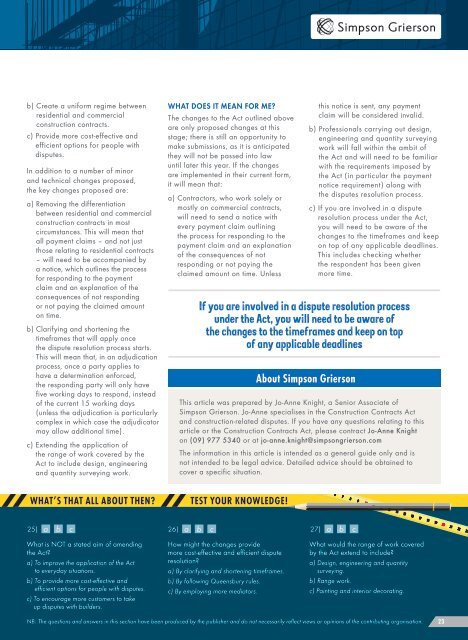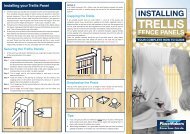what we learned from christchurch taking the risk out ... - PlaceMakers
what we learned from christchurch taking the risk out ... - PlaceMakers
what we learned from christchurch taking the risk out ... - PlaceMakers
Create successful ePaper yourself
Turn your PDF publications into a flip-book with our unique Google optimized e-Paper software.
) Create a uniform regime bet<strong>we</strong>enresidential and commercialconstruction contracts.c) Provide more cost-effective andefficient options for people withdisputes.In addition to a number of minorand technical changes proposed,<strong>the</strong> key changes proposed are:a) Removing <strong>the</strong> differentiationbet<strong>we</strong>en residential and commercialconstruction contracts in mostcircumstances. This will mean thatall payment claims – and not justthose relating to residential contracts– will need to be accompanied bya notice, which <strong>out</strong>lines <strong>the</strong> processfor responding to <strong>the</strong> paymentclaim and an explanation of <strong>the</strong>consequences of not respondingor not paying <strong>the</strong> claimed amounton time.b) Clarifying and shortening <strong>the</strong>timeframes that will apply once<strong>the</strong> dispute resolution process starts.This will mean that, in an adjudicationprocess, once a party applies tohave a determination enforced,<strong>the</strong> responding party will only havefive working days to respond, insteadof <strong>the</strong> current 15 working days(unless <strong>the</strong> adjudication is particularlycomplex in which case <strong>the</strong> adjudicatormay allow additional time).c) Extending <strong>the</strong> application of<strong>the</strong> range of work covered by <strong>the</strong>Act to include design, engineeringand quantity surveying work.WHAT DOES IT MEAN FOR ME?The changes to <strong>the</strong> Act <strong>out</strong>lined aboveare only proposed changes at thisstage; <strong>the</strong>re is still an opportunity tomake submissions, as it is anticipated<strong>the</strong>y will not be passed into lawuntil later this year. If <strong>the</strong> changesare implemented in <strong>the</strong>ir current form,it will mean that:a) Contractors, who work solely ormostly on commercial contracts,will need to send a notice wi<strong>the</strong>very payment claim <strong>out</strong>lining<strong>the</strong> process for responding to <strong>the</strong>payment claim and an explanationof <strong>the</strong> consequences of notresponding or not paying <strong>the</strong>claimed amount on time. Unlessthis notice is sent, any paymentclaim will be considered invalid.b) Professionals carrying <strong>out</strong> design,engineering and quantity surveyingwork will fall within <strong>the</strong> ambit of<strong>the</strong> Act and will need to be familiarwith <strong>the</strong> requirements imposed by<strong>the</strong> Act (in particular <strong>the</strong> paymentnotice requirement) along with<strong>the</strong> disputes resolution process.c) If you are involved in a disputeresolution process under <strong>the</strong> Act,you will need to be aware of <strong>the</strong>changes to <strong>the</strong> timeframes and keepon top of any applicable deadlines.This includes checking whe<strong>the</strong>r<strong>the</strong> respondent has been givenmore time.If you are involved in a dispute resolution processunder <strong>the</strong> Act, you will need to be aware of<strong>the</strong> changes to <strong>the</strong> timeframes and keep on topof any applicable deadlinesAb<strong>out</strong> Simpson GriersonThis article was prepared by Jo-Anne Knight, a Senior Associate ofSimpson Grierson. Jo-Anne specialises in <strong>the</strong> Construction Contracts Actand construction-related disputes. If you have any questions relating to thisarticle or <strong>the</strong> Construction Contracts Act, please contract Jo-Anne Knighton (09) 977 5340 or at jo-anne.knight@simpsongrierson.comThe information in this article is intended as a general guide only and isnot intended to be legal advice. Detailed advice should be obtained tocover a specific situation.WHAT’S THAT ALL ABOUT THEN?TEST YOUR KNOWLEDGE!25) a b c26) a b c27) a b cWhat is NOT a stated aim of amending How might <strong>the</strong> changes provideWhat would <strong>the</strong> range of work covered<strong>the</strong> Act?more cost-effective and efficient dispute by <strong>the</strong> Act extend to include?a) To improve <strong>the</strong> application of <strong>the</strong> Act resolution?a) Design, engineering and quantityto everyday situations.a) By clarifying and shortening timeframes. surveying.b) To provide more cost-effective andb) By following Queensbury rules.b) Range work.efficient options for people with disputes. c) By employing more mediators.c) Painting and interior decorating.c) To encourage more customers to takeup disputes with builders.B: The questions and ans<strong>we</strong>rs in this section have been produced by <strong>the</strong> publisher and do not necessarily reflect views or opinions of <strong>the</strong> contributing organisation.NB: The questions and ans<strong>we</strong>rs in this section have been produced by <strong>the</strong> publisher and do not necessarily reflect views or opinions of <strong>the</strong> contributing organisation.23
















